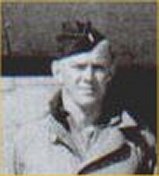 |
"When I arrived at Stalag Luft 1, they had recently openned North 1 Compound and our train load of new arrivals (arriving in box cars) were marched through the small town of Barth enroute to the camp about a mile away. The local women shouted at us and hit us with brooms. rakes etc as we marched past them. We were assigned 14 to a room, double bunks. The room had a small cast iron stove in one corner, an oak table that could seat six on two benches, one 40watt light bulb, and double windows which were covered at night by outside shutters. Above the window was an opening about eight inches wide which had a cardboard cover that could be slid open after we were shuttered-in and lights were out. Guards with dogs, patrolled the grounds. We had one sheet, one thin blanket and slept on straw filled mattresses. In the winter we slept in our clothes and an overcoat. It was the coldest winter in years for that area."
"Red cross parcels were issued once a week in the beginning. Several of the items were taken for the kitchen. We had a large building that could seat several hundred at a time. We had barley, with bugs, in the morning, a little food the Germans provided, and something from the red cross parcel like Spam. The mess hall burned down shortly after our arrival. Next to the mess hall was a dug out basin to catch water used to fight fires. It was not sufficient (to save the mess hall). After that we got food directly to each POW, but the parcels were giving out and distribution reduced until there was none in the spring of l945."
"We had a secret newspaper. The British in compound 1 had gotten radio parts from a guard in one of the towers who had fallen asleep, and they knocked on one of his legs to awaken him and told him he was going to be reported to German Headquarters. He offered a present if they did not report him. The British then had a radio and listened to the BBC once a day. Notes were taken on toilet paper and the Catholic priest carried them in a false watch from compound to compound. Lowell Bennett, an International News Service young reporter who had been shot down while riding with the British on a night raid, expanded the news and published the paper know as POW WOW - Prisoners of War Waiting on Winning."
"My bunk mate in the lower bunk, Phillip Melnick, was of Russian Jewish ancestry. He was taken, along with all other Jewish soldiers and put in a barracks by themselves. Story was they were to be executed, but with the end of the war not far away, the orders were not carried out."
"The Russian Army liberated us and held us for two weeks while they compiled information on all 10,000 prisoners. We were flown out of Barth airport by the 8th airforce. Then a train ride, with milkshakes three times a day to fatten us up, to Camp Lucky Strilke in France. There were over 50,000 liberated prisoners there. That is where Samuel Fischler jumped down from an open truck when he saw me. It was the first I knew that the crew had survived the war."